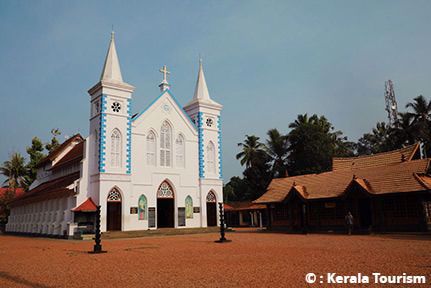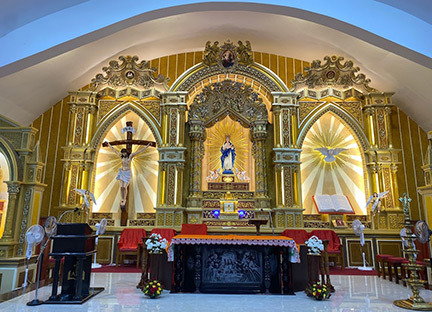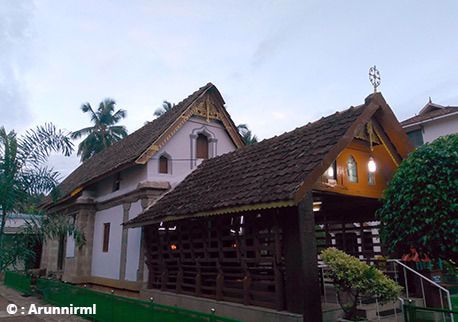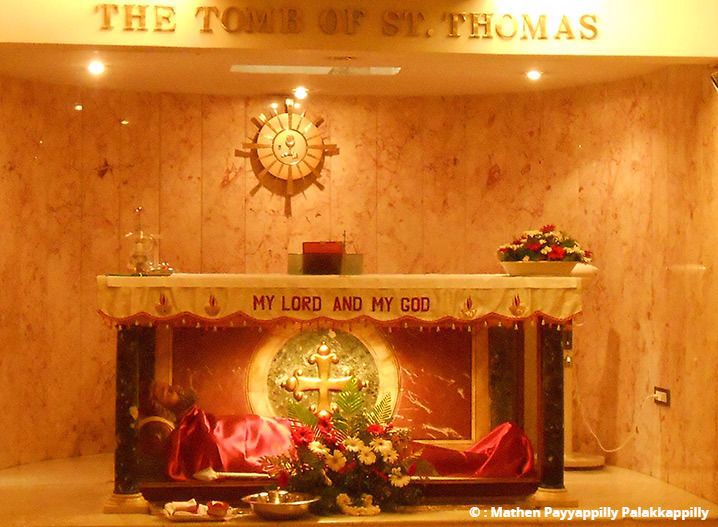St. Thomas Syro-Malabar Catholic Church, Palayur:
 One of Kerala's oldest churches, it is believed to be the place where St. Thomas conducted first baptism in India. This gives it the status of the Apostolic Church. It is one of the three churches whose location was not changed unlike other four churches.
One of Kerala's oldest churches, it is believed to be the place where St. Thomas conducted first baptism in India. This gives it the status of the Apostolic Church. It is one of the three churches whose location was not changed unlike other four churches.
 Kottakkavu Mar Thoma Church (Cochin):It is another church of religious significance and is believed to have possessed until the 18th century the wooden cross planted by St. Thomas. But it was vandalized by the successive local rulers.
Kottakkavu Mar Thoma Church (Cochin):It is another church of religious significance and is believed to have possessed until the 18th century the wooden cross planted by St. Thomas. But it was vandalized by the successive local rulers.
Another one engraved in the rock here, is believed to be Persian which was erected in 880 AD.
St. Thomas Syro-Malabar Catholic Church, Kokkamangalam: It is believed that St. Thomas preached and converted around 1600 people to Christianity in this church.
 The wooden cross planted here was cut and thrown into the Vembanad lake by the opponents, but interestingly it floated up to Pallippuram (5 kms away), and was enshrined in the Church over there.
The wooden cross planted here was cut and thrown into the Vembanad lake by the opponents, but interestingly it floated up to Pallippuram (5 kms away), and was enshrined in the Church over there.
 St. Mary's Church, Niranam: This Church is believed to have been reconstructed several times and what we see today is the fourth church built on the same. The Church is dedicated to Saint Mary and for the founder, St. Thomas.
St. Mary's Church, Niranam: This Church is believed to have been reconstructed several times and what we see today is the fourth church built on the same. The Church is dedicated to Saint Mary and for the founder, St. Thomas.
Watch a short video on one of the church established by St Thomas in India.
St. Thomas Ecumenical Church, Nilakkal: This is an ecumenical Church, which is considered to be the symbol of unity among Christianity and other religions.
 The Church was built in a forest. Therefore after it was abandoned, it remained hidden under the thick forest cover for a long period of time. It was rediscovered only in 1902. According to a legend, St Thomas baptised around 1100 people in this church.
The Church was built in a forest. Therefore after it was abandoned, it remained hidden under the thick forest cover for a long period of time. It was rediscovered only in 1902. According to a legend, St Thomas baptised around 1100 people in this church.
 Our Lady of purification Church, Kollam: The strategic location of Kollam on the trade route of Kerala convinced St Thomas to establish a church here, which is today also known as Kollam Port Church. However, due to the sea erosion, the church had to be reconstructed thrice.
Our Lady of purification Church, Kollam: The strategic location of Kollam on the trade route of Kerala convinced St Thomas to establish a church here, which is today also known as Kollam Port Church. However, due to the sea erosion, the church had to be reconstructed thrice.
St. Mary's Arappali Church, Thiruvithamcode:
 This is believed to be the oldest existing church structure of the world. It was never reconstructed and is still in worship. The Chera king gave the land for the Church and thus it is also called 'Arrappaly', which means half Church.
This is believed to be the oldest existing church structure of the world. It was never reconstructed and is still in worship. The Chera king gave the land for the Church and thus it is also called 'Arrappaly', which means half Church.
Therefore the group of eight churches is called seven and a half churches.
St. Thomas was the only one who questioned the resurrection of Christ initially. Instead of believing in what other apostles mentioned, he asked for proof. He had been quoted saying that “only when he would see the nail marks on His hands, touch and feel His wounds, would he believe in the resurrection”. When Jesus came in front of him, all his doubts converted into concrete beliefs. This might be the reason for his ability to spread the religion with conviction which resulted in numerous people to embrace Christianity. St. Thomas founded various churches and chose the Jewish colonies along the sea coast, Periyar River, and its tributaries for spreading the Christianity.
After Kerala, he moved to the Coromandel Coast (east coast of India) to spread the message and landed in Mylapore in Tamil Nadu. Here also he chose to convert people to Christianity through evangelism, but it could not last for a longer time due to the resistance from other religious followers.
Here are some of the monuments associated with him on the Coromandel Coast (east coast):
Little Mount (Chennai): A cave on this hillock was his residence where he lived, prayed, meditated and preached Christianity. However, this did not go well with the preachers of other religions, and they confronted him. During his last days, St. Thomas escaped the assailants through the narrow opening on the other side of the cave. One can access that cave opening, where his hand and footprints are still engraved on the rock. When the Portuguese arrived in India, they realized the religious importance of this place and built a Church at that place which is known as Our Lady of the Health Church.
St. Thomas Mount (Chennai): Though St. Thomas managed to escape from the cave he could not go far enough. The assailants speared him to death on this mount, and the mount was named as St. Thomas Mount. The Portuguese built a church of mother Mary here as well and named it as Our Lady of expectations. The stone cross placed in the Church is believed to be held by St. Thomas during his death and thus had blood strains. The cross is believed to be miraculous and is called a bleeding cross. Apart from the religious significance, one can get panoramic views of the city from St. Thomas Mount.
St. Thomas Cathedral Basilica (Chennai): After the death of St. Thomas, his mortal remains were brought and buried at the place where St. Thomas church was erected.
 This church is one of the three known churches in the world built over the remains of an apostle of Jesus that are still standing today, the other two being St Peter's Basilica in Vatican City and Santiago de Compostela Cathedral in Spain.
This church is one of the three known churches in the world built over the remains of an apostle of Jesus that are still standing today, the other two being St Peter's Basilica in Vatican City and Santiago de Compostela Cathedral in Spain.
However the present church is not the original building structure. It was reconstructed like other churches.
So believe us when we say, India is truly a land of enlightenment that will mystify you to your soul! Come and explore this mystifying land with us! At Indo Asia Tours, the itinerary is not just a travel route or a trip. We design, conceptualise and handcraft every journey for your esteemed clients. Our special customised itineraries and curated experiences in different destinations are what make for those memorable travel moments.


 One of Kerala's oldest churches, it is believed to be the place where St. Thomas conducted first baptism in India. This gives it the status of the Apostolic Church. It is one of the three churches whose location was not changed unlike other four churches.
One of Kerala's oldest churches, it is believed to be the place where St. Thomas conducted first baptism in India. This gives it the status of the Apostolic Church. It is one of the three churches whose location was not changed unlike other four churches.
 Kottakkavu Mar Thoma Church (Cochin):It is another church of religious significance and is believed to have possessed until the 18th century the wooden cross planted by St. Thomas. But it was vandalized by the successive local rulers.
Kottakkavu Mar Thoma Church (Cochin):It is another church of religious significance and is believed to have possessed until the 18th century the wooden cross planted by St. Thomas. But it was vandalized by the successive local rulers.
 The wooden cross planted here was cut and thrown into the Vembanad lake by the opponents, but interestingly it floated up to Pallippuram (5 kms away), and was enshrined in the Church over there.
The wooden cross planted here was cut and thrown into the Vembanad lake by the opponents, but interestingly it floated up to Pallippuram (5 kms away), and was enshrined in the Church over there.
 St. Mary's Church, Niranam: This Church is believed to have been reconstructed several times and what we see today is the fourth church built on the same. The Church is dedicated to Saint Mary and for the founder, St. Thomas.
St. Mary's Church, Niranam: This Church is believed to have been reconstructed several times and what we see today is the fourth church built on the same. The Church is dedicated to Saint Mary and for the founder, St. Thomas.
 The Church was built in a forest. Therefore after it was abandoned, it remained hidden under the thick forest cover for a long period of time. It was rediscovered only in 1902. According to a legend, St Thomas baptised around 1100 people in this church.
The Church was built in a forest. Therefore after it was abandoned, it remained hidden under the thick forest cover for a long period of time. It was rediscovered only in 1902. According to a legend, St Thomas baptised around 1100 people in this church.
 Our Lady of purification Church, Kollam: The strategic location of Kollam on the trade route of Kerala convinced St Thomas to establish a church here, which is today also known as Kollam Port Church. However, due to the sea erosion, the church had to be reconstructed thrice.
Our Lady of purification Church, Kollam: The strategic location of Kollam on the trade route of Kerala convinced St Thomas to establish a church here, which is today also known as Kollam Port Church. However, due to the sea erosion, the church had to be reconstructed thrice.
 This is believed to be the oldest existing church structure of the world. It was never reconstructed and is still in worship. The Chera king gave the land for the Church and thus it is also called 'Arrappaly', which means half Church.
This is believed to be the oldest existing church structure of the world. It was never reconstructed and is still in worship. The Chera king gave the land for the Church and thus it is also called 'Arrappaly', which means half Church.
 This church is one of the three known churches in the world built over the remains of an apostle of Jesus that are still standing today, the other two being St Peter's Basilica in Vatican City and Santiago de Compostela Cathedral in Spain.
This church is one of the three known churches in the world built over the remains of an apostle of Jesus that are still standing today, the other two being St Peter's Basilica in Vatican City and Santiago de Compostela Cathedral in Spain.
 We can conduct a virtual destination awareness training program for your team or yourself or a virtual tour for your clients. Let us know the destination of your interest along with your convenient date / time and we will be happy to set up a program for you.
We can conduct a virtual destination awareness training program for your team or yourself or a virtual tour for your clients. Let us know the destination of your interest along with your convenient date / time and we will be happy to set up a program for you.

